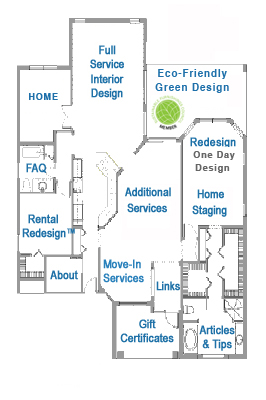
Serving:
New
York Greater Metropolitan Tri-State Area (NY,
NJ, CT)
Peggy Berk IDS - Associate Certified Interior Refiner Telephone: 917.754.6535 pberk@areaaesthetics.com

|
|||||||||||||
Rental Redesign™:
Studio Sense
Put your design focus on function and lifestyle to make a small studio work in a big way.

By
Peggy Berk
Interior Decorator & Certified Interior Refiner
Area
Aesthetics
Studio
apartments less than 400 square feet aren’t all that uncommon
in the rental market, especially in desirable urban neighborhoods.
Unfortunately, the trade-off for high-end amenities and a great location
is often that your rental dollars buy very little living space.
 I
recently designed a 375 square foot studio rental in one of Manhattan’s
poshest buildings. Small as it was, this studio had
a separate full-sized kitchen and a very large bath, leaving
a room slightly under
220 square feet to accommodate all of the tenant’s other
needs. The functional requirements were formidable. A conversation
area suitable
for small scale entertaining, a media and storage unit, dining
for two and a bed are generally on the list. However, this tenant
also
needed a second bed for her mother, who is an occasional overnight
visitor, and a work area that could support her professional
needs as a full-time work-at-home writer.
I
recently designed a 375 square foot studio rental in one of Manhattan’s
poshest buildings. Small as it was, this studio had
a separate full-sized kitchen and a very large bath, leaving
a room slightly under
220 square feet to accommodate all of the tenant’s other
needs. The functional requirements were formidable. A conversation
area suitable
for small scale entertaining, a media and storage unit, dining
for two and a bed are generally on the list. However, this tenant
also
needed a second bed for her mother, who is an occasional overnight
visitor, and a work area that could support her professional
needs as a full-time work-at-home writer.
When a studio is being designed for full time living and working,
it is very important to create a real sense of home and to provide distinct
areas for different functional aspects. Entertaining friends
in a space that doesn’t telegraph its alternative function as a
bedroom shouldn’t be considered a luxury, no matter how small the
space. Too, while it may be okay to use a dining table for occasional
work at home, a full time home office should be contained in a separate
area of the studio. This will allow for relaxed dining and the ability
to separate from work-related stresses when it’s time to kick
back and unwind at the end of the day.
In any small space, it is important to be aware of scale and
to keep all of the furnishings harmonious. Rather than go
for the largest seating your room can accommodate, go for the smallest
that will do the job. Lower furniture will add a sense of volume to
a room, expanding it visually. Place the taller furniture against a
far wall, if possible, keeping a clear line of sight into the room.
When it comes to style, the eclecticism that can work so well in larger
rooms serving just one or two functions, can easily cross the line
into a cluttered look if not handled deftly in a multi-functional studio.
Choosing a more homogenous style will help you to maintain a sense
of harmony.
Another element to watch is your traffic pattern. When
arranging your furniture, try to create one main traffic route
that can be used to access all of the different areas in the
studio. Avoid patterns
that transverse functional areas or weave in and out among them.
An “L-shaped” pattern
will not only keep you and your guests from bumping into each other,
but will also preserve the maximum amount of space for your furnishings
and help to separate and define functional areas.
The major challenge in the diminutive studio
I recently designed was finding the room for two separate sleepers
without encroaching on the area that we wanted to set aside for work.
The sleep sofa has been a mainstay of studio living
for as long as I can remember. I think a convertible
is fine for the occasional overnight guest. However, it has
never been
my favorite solution for a bed that will be used daily because
I’ve
never met a client who didn’t dread the pull-out-the-bed
ritual that usually involves rearranging at least some of the
other furniture
in the room.
Clients who call me looking for a better solution have
so tired of the nightly ritual that, unless they are expecting
company, they no longer bother to close the sofa bed and
leave the cocktail table and other furnishings that had to
be moved strewn
dysfunctionally around the room. To make matters worse, the
other seating in the room is now permanently occupied by the
displaced
sofa cushions. When they’ve reached this point, the
studio may be working as a bedroom, but it no longer functions
on any
other level.
Unless your studio is unusually large, I have
found the best solution is the traditionally sized daybed, which
uses a 33” wide mattress. Larger than half of a queen
sized mattress, but narrow enough to look and sit like
a sofa, the
daybed handles its double-duty with great style.
The downside is that the traditional 33” daybed
is increasingly difficult to find.
Whereas once daybeds were defined by the mattress size,
this is no longer the case as the term now specifies
a style of bed that is designed to sit parallel,
rather than perpendicular, to the wall. Of the two top manufacturers
of daybeds, one no longer makes anything smaller than
a twin and the second only carries
two models in the 33” size. Invariably, a twin-sized daybed looks like
a bed, not a sofa, and its 39” mattress makes for very uncomfortable
seating.
If you’re shopping for a traditional
daybed, be very clear about the size you want. You
can also try asking for “studio sofas” and even
chaises, some of which will fill the bill nicely despite
the confusing nomenclature. If the innerspring or foam
mattress isn’t quite up to everyday sleeping standards,
you can find quality, well-priced 33” daybed
mattresses through 1-800-Mattres.
For the occasional guest, there are lots
of interesting convertible solutions. One of the
most innovative in the market is a rattan, leather and
mahogany travel trunk from Bauer International that converts
to a twin bed with an innerspring mattress. What makes
it extra special is its leather headboard unit comprising
shelves and closed compartments, making it a great solution
if you have longer-term guests who will be needing some
of their own storage space, as well.
To complement a daybed of woven chocolate
sea grass upholstered in a British Colonial
inspired fabric in the studio I designed, I chose a
brown leather
ottoman that opens to a twin size bed for mom’s
overnight visits. The ottoman does double duty as a
table and only
necessitates moving two small chairs a few inches back
to accommodate the bed.
Making a small studio work well requires
good “studio sense,” and that means
an unwavering focus on function and lifestyle as you
design your way to a great looking room.
![]() Peggy
Berk, IDS-Associate, is an interior decorator and certified interior
redesigner. Her
design firm, Area Aesthetics, specializes in interior redesign,
home staging and full service interior decorating. A renter
herself for the past 30 years, she has lived in, and redesigned
many times over, the parlour floor of a townhouse in
New York City. She has worked with a wide variety of clients
living in rental homes throughout the New York Metropolitan Area
and Florida.
Peggy
Berk, IDS-Associate, is an interior decorator and certified interior
redesigner. Her
design firm, Area Aesthetics, specializes in interior redesign,
home staging and full service interior decorating. A renter
herself for the past 30 years, she has lived in, and redesigned
many times over, the parlour floor of a townhouse in
New York City. She has worked with a wide variety of clients
living in rental homes throughout the New York Metropolitan Area
and Florida.
COMING
SOON
Rental Redesign™
www.rentalredesign.com
a new publication based on
Peggy's popular
"Rental Redesign" column!
Bringing you original articles
every month
by some of today's
top interior redecorators.
Resale Redesign Home Staging Rental Redesign FAQ
Decorator Consulting & Shopping Services
Full Service Interior Design Decorating Gift Certificates
About Peggy Berk and Area Aesthetics Contact
Move-in Services Decorating & Interior Redesign Links
Interior Redesign Articles, Tips & Decorating Ideas



